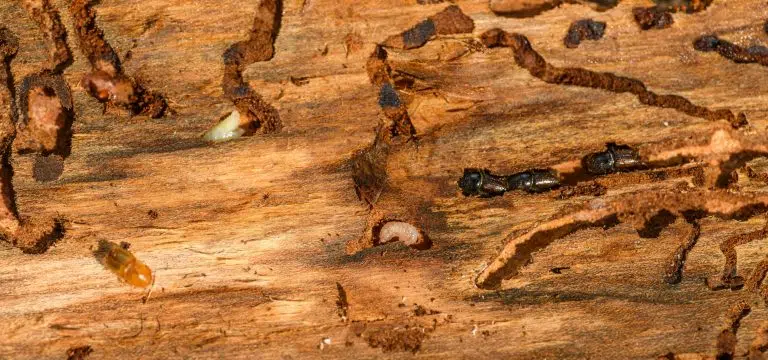Termites are destructive pests that often cause damage before anyone notices. Therefore, early detection is important for every homeowner.
Termite activity is often hidden, hence many infestations go untreated until visible issues appear. However, there are signs you can look for to stop termites before they do major damage. These clues may seem small, but they usually mean something more serious than you think is happening inside your walls or floors.
We’ve created a clear checklist of termite warning signs that should never be ignored. By inspecting your home regularly, you can avoid long-term infestations. You can also ensure proper treatment by calling a pest control professional as early as the first sign.
Each of the following ten signs can appear alone or in combination, depending on the infestation. So, if you see even one of them, take action right away. Don’t give them a chance to destroy your investment.
1. Hollow-Sounding Wood
Termites eat wood from the inside out, which is why it sounds hollow when tapped. Therefore, check your walls, floors, and baseboards regularly. These areas often look solid from the outside, making this sign easy to miss.
You can catch this sign early by tapping the surface with a screwdriver or your knuckle. If the sound is dull or hollow, it may be infested inside. Floors may also feel softer or weaker when walked on.
Always compare suspicious areas to undamaged wood nearby. Although age may cause changes in wood, termites create a distinct hollow sound. When combined with other signs, hollow wood becomes a clearer warning.
If you discover multiple hollow-sounding spots, it is best to call a professional. Acting as quickly as possible can save thousands in structural repair later on. Don’t ignore this sign, but investigate further and confirm a cause.
2. Mud Tubes
Mud tubes are one of the most visible signs of a subterranean termite infestation. These narrow tunnels connect termite nests to their food source—your home.
Termites need moisture and protection from open air, so they build mud tubes to travel safely. You’ll often find them on foundations, crawl spaces, and exterior walls. If you break one open, you may see termites actively moving inside. Additionally, even old or dry tubes can signal a previous or inactive infestation. So, don’t ignore them—even if they seem abandoned.
These tubes are typically pencil-sized and can run vertically or horizontally along surfaces. While some homeowners mistake them for dirt or debris, they are made of soil, wood particles, and termite saliva. For that reason, they feel gritty and are easy to identify once you know what to look for. If you find mud tubes inside your home, the infestation may be advanced. Always contact a licensed termite specialist immediately. Prompt treatment stops the colony from spreading and causing further damage.
3. Discarded Wings
When termites swarm to form new colonies, they shed their wings shortly afterward. Therefore, piles of wings are a strong warning sign. Termite swarms are brief, and you might see them happening. However, discarded wings remain behind—usually near doors, windows, or light fixtures. These locations attract swarmers due to light and easy access points.
Termite wings are also uniform in size and longer than their bodies, unlike ant wings. Hence, you can confirm their identity by closely inspecting the shape.
While you might assume the problem is small, discarded wings indicate that a colony is already established nearby. Seeing wings indoors also suggests that termites have entered your home. If wings appear in multiple rooms, this means the infestation could be widespread.
You can take a photo or save a sample to show a pest control expert. Swarmers only appear when a colony matures, so their presence should never be ignored.
4. Termite Droppings (Frass)
Drywood termites leave behind tiny, wood-colored droppings known as frass. These small pellets resemble sawdust or coffee grounds. Therefore, they’re often mistaken for dirt or debris. However, unlike sawdust, frass pellets are oval-shaped with ridges.
Drywood termites live inside the wood they consume, so their droppings come out of small holes. Frass are usually found beneath wooden furniture, along baseboards, or windowsills. If you attempt to sweep them away and they return, this proves that an infestation is active. Although these droppings don’t cause harm themselves, they are signs of hidden damage. Termites may be tunneling through furniture, flooring, or support beams nearby.
Collect a sample and compare it to online images or ask a professional. If it matches frass, schedule an inspection immediately. Because drywood termites don’t need soil contact, they can spread quietly indoors. Taking action quickly limits damage and ensures proper treatment.
5. Sagging Floors and Bubbling Paint
Structural damage from termites often appears as sagging floors or bubbling paint. Although these may be mistaken as water damage, they often result from termite activity.
Termites feed on wood from within, making surfaces lose stability and begin to warp. Therefore, if your floor feels spongy or uneven, investigate immediately. Bubbling or peeling paint may occur when termites create tunnels behind walls. Additionally, you might notice baseboards pulling away or nails loosening. While seasonal moisture can also cause these problems, termite damage progresses over time. So, check for other signs like frass or hollow wood nearby.
Warped floors and bulging walls usually point to hidden issues. In fact, many termite infestations are discovered during repairs for sagging structures. Don’t patch over the damage without identifying the cause. If termites are present, cosmetic fixes won’t stop further deterioration. Contact a pest control expert to determine the source and recommend treatment. Catching it early can save both time and money in the long run.
Interested in reading about Why New Homes Are Still At Risk For Termites (And What Builders Don’t Tell You)?




